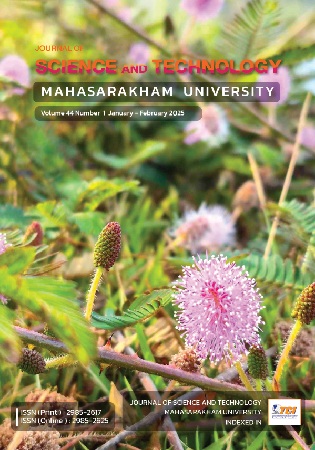A model for analyzing the severity level of adverse drug reactions using machine learning
Main Article Content
Abstract
Psychiatric drugs are a class of central nervous system stimulants with a high number of reported adverse drug reactions, ranking among the top five drug classes for adverse events. Pharmacovigilance (PV) is a crucial process for identifying, evaluating, and preventing potential adverse events. This process is complex, time-consuming, and dependent on the experience and analytical knowledge of medical personnel. Therefore, this study aims to develop a model for analyzing the severity of Adverse Drug Reactions (ADRs) using Machine Learning. The process includes model preprocessing, feature selection, and learning data sets. Five machine learning techniques were applied: K-Nearest Neighbors, Linear Support Vector Machine, Logistic Regression, Random Forest, and Artificial Neural Network. The evaluation of model performance using various techniques showed that the Artificial Neural Network model performed best in classifying the severity of ADRs. The model's performance, evaluated using Stratified 10-Fold Cross Validation, yielded an accuracy of 80.60% and an overall efficiency of 77.85%. The model demonstrated a strong ability to classify cases with moderate to severe ADRs as well as non-ADR cases. The key features that contributed to the model's effectiveness in classifying severity include the relevance of PRN or LNC medication administration, receipt of high-alert drugs, history of allergies, ward type, ICD code F250 (main disease), diagnostician, season (winter), urgency, and patient condition upon arrival at the hospital.
Article Details
References
กลุ่มนโยบายแห่งชาติด้านยา (2559). คู่มือการใช้ยาอย่างสมเหตุผล ตามบัญชียาหลักแห่งชาติ ยาที่ใช้ทางจิตเวชศาสตร์. http://ndi.fda.moph.go.th/Drug_national
กิตติพนธ์ เครือวงค์. (2561). ความคลาดเคลื่อนทางยา. วารสารกฎหมายสุขภาพและสาธารณสุข, 4(2), 254-265.
บงกช เพียรไทย และกรรณิการ์ เวชคุณานุกูล. (2563). ความสัมพันธ์ระหว่างปัจจัยและระดับความร้ายแรงของเหตุการณ์ไม่พึงประสงค์จากการใช้ยาโรงพยาบาลพระนารายณ์มหาราช : การศึกษาภาคตัดขวาง. วารสารสุขภาพและสิ่งแวดล้อมศึกษา, 5(2), 134-146.
รุ่งนภา ทรงศิริพันธุ์. (2561). ปัจจัยที่มีความสัมพันธ์กับระดับความรุนแรงของอาการไม่พึงประสงค์จากการใช้ยา. วารสารเครือข่ายวิทยาลัยพยาบาลและการสาธารณสุขภาคใต้, 5(2), 46-56.
ศูนย์เฝ้าระวังความปลอดภัยด้านผลิตภัณฑ์สุขภาพ. (2565). Infographic สถิติข้อมูลศูนย์เฝ้าระวังความปลอดภัยด้านผลิตภัณฑ์สุขภาพ. http://hpvc.fda.moph.go.th/AEINFO/InfographicIndex.aspx
Alomar, M. J. (2014). Factors affecting the development of adverse drug reactions. Saudi Pharmaceutical Journal, 22(2), 83–94. https://doi.org/10.1016/j.jsps.2013.02.003
FDA US. Food and Drug Administration. (2022). FDA Adverse Events Reporting System (FAERS) Public Dashboard. https://fis.fda.gov/hub
Gao, Z., Yang, Y., Meng, R., Yu, J., & Zhou, L. (2022). Automatic assessment of adverse drug reaction reports with interactive visual exploration. Scientific Reports, 12(1), 6777. https://doi.org/10.1038/s41598-022-10887-5
Guo, K., Feng, Z., Chen, S., Yan, Z., Jiao, Z., & Feng, D. (2022). Safety profile of antipsychotic drugs: analysis based on a provincial spontaneous reporting systems Database. Frontiers in Pharmacology, 13. https://doi.org/10.3389/fphar.2022.848472
Iqbal, E. (2021). Investigating adverse effects of psychiatric drugs through data mining of electronic health records (Doctoral dissertation, King's College London).
Islam, T., Hussain, N., Islam, S., & Chakrabarty, A. (2018, December). Detecting adverse drug reaction with data mining and predicting its severity with machine learning. In 2018 IEEE region 10 humanitarian technology conference (R10-HTC) (pp. 1-5). IEEE. https://doi.org/10.1109/R10-HTC.2018.8629806
Lai, N. H., Shen, W. C., Lee, C. N., Chang, J. C., Hsu, M. C., Kuo, L. N., Yu, M. C., & Chen, H. Y. (2020). Comparison of the predictive outcomes for anti-tuberculosis drug-induced hepatotoxicity by different machine learning techniques. Computer Methods and Programs in Biomedicine, 188. https://doi.org/10.1016/j.cmpb.2019.105307
Liu, J. Y. H., & Rudd, J. A. (2023). Predicting drug adverse effects using a new Gastro-Intestinal Pacemaker Activity Drug Database (GIPADD). Scientific Reports, 13(1), 6935. https://doi.org/10.1038/s41598-023-33655-5
Mohsen, A., Tripathi, L. P., & Mizuguchi, K. (2021). Deep learning prediction of adverse drug reactions in drug discovery using open TG–GATEs and FAERS databases. Frontiers in Drug Discovery, 1. https://doi.org/10.3389/fddsv.2021.768792
Nishioka, S., Watanabe, T., Asano, M., Yamamoto, T., Kawakami, K., Yada, S., ... & Hori, S. (2022). Identification of hand-foot syndrome from cancer patients’ blog posts: BERT-based deep-learning approach to detect potential adverse drug reaction symptoms. PloS one, 17(5). https://doi.org/10.1371/journal.pone.0267901
Rakhsha, M., Keyvanpour, M. R., & Shojaedini, S. V. (2021, May). Detecting adverse drug reactions from social media based on multichannel convolutional neural networks modified by support vector machine. In 2021 7th International Conference on Web Research (ICWR) (pp. 48-52). IEEE. https://doi.org/10.1109/ICWR51868.2021.9443128
Sisay, T. & Wami, R. (2021). Adverse drug reactions among major depressive disorders: patterns by age and gender. Heliyon, 7(12), 1-6. https://doi.org/10.1016/j.heliyon.2021.e08655
World Health Organization. (2021, August 3). The Global Patient Safety Action Plan 2021-2030. https://www.who.int.


